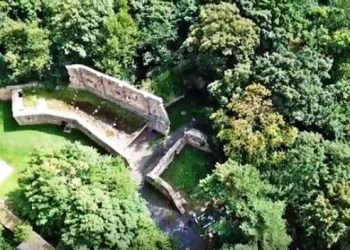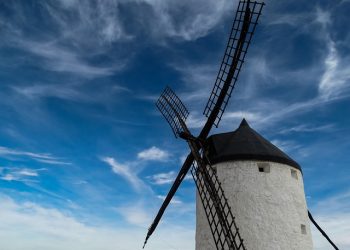Since 1732, the Burgenland region provided the Jews who lived there with the possibility of an autonomous life. It was the only region in Europe where the Jewish community had independence while cooperating with the local population. The Jewish communities focused on Torah study while integrating and adapting to a modern way of life. Most of the Jewish communities were Orthodox and maintained a mutual connection with the Orthodox community of Jews in Vienna.
Historical Background
Some claim that Jewish settlement in the Burgenland region began as early as the 8th century AD. However, the first evidence of a Jewish community in the area dates back to 1296 – the Jewish community in Eisenstadt. Over the years, 7 Jewish communities grew in the Burgenland region (known as the “Seven Holy Communities”). These communities revolved around yeshivas, and each community was led by an ordained rabbi. The 7 Jewish communities had a close relationship with the local population and with the capital city of Sopron.
Throughout history, the Jewish community in Burgenland received rights and benefits from the local rulers:
- 1496: The ruler Maximilian helped Jews who were exiled from the Styria region (Austria) to settle in Burgenland.
- 1529: The ruler Ferdinand renewed the rights of the Jews of Eisenstadt, Mattersburg, and Kobersdorf.
- 1622-1626: The Jewish communities in northern Burgenland were protected by the Esterházy count family, while the communities in the south received protection from the Batthyány-Strattmann and Nádasdy counts.
In 1647, the Burgenland region belonged to the House of Habsburg and was officially part of Hungary. In the years 1670-1671, as part of the expulsion of Jews from Lower Austria, the Jewish communities in Burgenland were also required to leave. However, the expulsion was very short-lived, and the Jewish communities managed to return to Burgenland. In 1700 AD, there were 12 Jewish communities in Burgenland. 7 of the communities were located in northern Burgenland and received protection and autonomy from Count Esterházy, while the other 5 communities were in the south. The 7 northern communities would hold monthly meetings in Eisenstadt, where they would discuss the communities’ way of life and the giving of tributes to Count Esterházy in order to maintain their status and autonomy. Over the years, the Jewish communities had to pay a special tax to maintain their autonomy.
In 1840, the Hungarian Parliament approved the law of free settlement for Jews and freedom of occupation. Consequently, Jews were no longer obliged to remain in the communities and under a limited framework of work. As a result of this law and the Austro-Hungarian Revolution of 1848, all Jewish communities in Burgenland, except for Eisenstadt and Mattersburg, lost their autonomy, and most of the Jews in the area chose to leave and resettle in Vienna. In 1850, the Jewish community in Burgenland numbered 8,487 Jews.
The Extermination of the Jews in Burgenland
In the 19th century, the Jewish community in Burgenland began to shrink, and the importance of life in the Jewish communities declined. In 1921, the Burgenland region officially became the 9th province of the state of Austria, and the existing communities were part of an Orthodox organization called Orthodoxe Israelitische Landeskanzlei.
In 1934, there were about 3,632 Jews in Burgenland (possibly 4,000 if conversions to Christianity are taken into account), and they were divided into 12 different communities.
7 of the Jewish communities were located in the northern part of Burgenland:
- Eisenstadt
- Mattersburg
- Lackenbach
- Deutschkreutz
- Kobersdorf
- Frauenkirchen
- Kittsee
While the 5 Jewish communities in southern Burgenland were considered commercial centers for the local population: Güssing, Rechnitz, Schlaining, Oberpullendorf, Gattendorf.
Towards World War II and the global economic crisis, more and more of the Burgenland population believed that a single, large German state was the solution to the crisis, and that the unification of Germany with Austria was necessary.
When the German occupiers arrived in Burgenland, most of the population received the Nazi forces with open arms under the assumption that the Nazis would provide the region with sources of income, work, and an improvement in the economic situation. On March 11, 1938, the Nazis occupied Burgenland. After the central speech of the party in the center of Eisenstadt, citizen revolutions against the Jewish community began.
The 7 Jewish communities in the north were threatened with stoning and looting to leave the area immediately. In one community, the Jews were even loaded onto trucks for departure. The Jews in Burgenland were forced to hand over their businesses and licenses to the local administration and to leave immediately. Jews who did not have a visa to cross the borders were transferred to Vienna for further processing. According to reports, as of June 1938, no people from the Jewish community remained in Burgenland.
The Jewish Quarter of Eisenstadt
The Jewish community in Eisenstadt is the oldest community in Burgenland and has been registered since 1296 AD as a central part of the 7 communities. The Jewish community in Eisenstadt suffered over the years until in 1732 it received protection from the local ruler of the Esterházy family.
From 1732, the Jews of Eisenstadt had independent autonomy throughout the city; the Jewish quarter was considered a protected area for the residents of the Jewish community. This area was also considered a commercial area for the non-Jewish residents of the city. With the Nazi occupation in 1938, the place became a ghetto for the Jewish community.
The Jewish center in Eisenstadt was considered a central place for Torah study and was even called “Little Jerusalem.” Examples of customs that characterized the Jewish quarter in the city:

- The entrances to the Jewish quarter on Shabbat were blocked with chains (one of which can still be seen today at the entrance to the old Jewish quarter).
- On the eve of Simchat Torah, it was the women’s task to take care of the Torah scrolls before the Hakafot (processions).
- During the cherry season, the first child to find a cherry with a worm inside would win a prize from the rabbi. This was a good example for the synagogue’s shamash (beadle) to show that one should not touch food from the harvest before inspection.
The Jews of Eisenstadt enjoyed autonomy during various periods, initially from the 17th century under the protection of the Esterházy count family. During this period, the Jews rebuilt the ancient synagogue (1834), established a mikveh (ritual bath) for purification in the city’s quarter, and a cemetery. Throughout history, this autonomy was maintained under Hungarian and then Austrian rule. With the Nazi occupation in 1938, the Jewish community in Burgenland was the first to experience the consequences of the Nazi occupier. The Jews of Eisenstadt were brutally expelled and lost their independence for the first time in 300 years. Furthermore, the homes of the Jews in the city were looted and burned, and the great synagogue in the city was completely destroyed. After 1945, very few of the Jews chose to return to Burgenland. Today, only about 2 Jewish families live in Eisenstadt, and about 12 in the entire region.
However, there is a small Jewish museum in the Jewish quarter where you can learn more about the lives of the Jews in Burgenland. The museum is located in an ancient synagogue and displays objects and writings related to the Jewish communities in Burgenland and the surrounding area. The museum is open to visitors from May to October (Tuesday to Sunday from 10:00 AM to 5:00 PM, closed on Mondays). The entrance fee is €5. You can find more information on the museum’s website.
Interested in more information about the city of Eisenstadt? Read more about the city and its palace in the comprehensive article we have prepared.


















